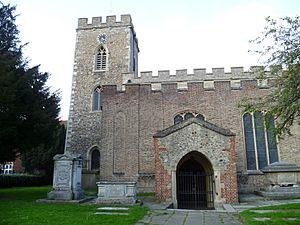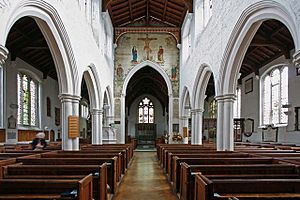St Andrew's Enfield facts for kids
Quick facts for kids St Andrew's Enfield |
|
|---|---|

St Andrew's Enfield
|
|
| Country | United Kingdom |
| Denomination | Church of England |
| Website | Official website: http://www.standrewsenfield.com/ |
| Architecture | |
| Heritage designation | Grade II* |
| Administration | |
| Parish | St Andrew's Enfield |
| Deanery | Enfield |
| Archdeaconry | Hampstead |
| Episcopal area | Edmonton |
| Diocese | London |
St Andrew's Enfield is a special Church of England church located in Enfield, London. It is the very first parish church of Enfield. This historic building is so important that it is listed as a grade II* listed building by Historic England. This means it's a building of great national importance.
Contents
The Church's Story: A Look Back in Time
When Did St Andrew's Begin?
The first time we find St Andrew's Church mentioned in writing was in 1136. At that time, it was given to a monastery in Walden, which is now called Saffron Walden.
In 1190, a leader named Abbot Reginald chose Robertus to be the first Vicar of Enfield. A vicar is like a main priest for the church.
How Old Are the Oldest Parts?
The oldest parts of St Andrew's Church were built soon after Robertus became vicar. You can still see parts of the east wall and the south wall of the sanctuary from this time.
The sanctuary is the holy area around the altar. There's a special window in the south wall. It's shaped like a lancet, which is a tall, narrow arch. This window used to be on the outside wall of the church.
Changes Over the Centuries
The 14th century was a busy time for the church. Many parts were repaired and made bigger. The north and south aisles were built. Aisles are the side sections of a church.
The south aisle was made taller in 1824. The church tower, which is a tall part of the building, also dates from the 14th century. It has been repaired and changed many times since then.
The arches in the nave are also from this period. The nave is the main part of the church where people sit.
Modern Additions and Memorials
The wooden pews, where people sit, were put in place in 1853. The special oak seats for the clergy and choir were added in 1908. These were a memorial to Prebendary Hodson, who was the Vicar of Enfield for many years.
A painting above the chancel arch was added in 1923. The chancel is the area near the altar. This painting remembers the brave men from Enfield who died in the First World War.
A Curious Message in the Churchyard
In the churchyard, there is an old stone with a strange message. It is for Thomas Carter, who passed away in 1742. The message says:
Wail not our fate, wail for thy own;
We rest in peace, while you drudge on.
This old message means: "Don't cry for us, cry for yourselves. We are resting peacefully, while you still have to work hard."
Images for kids








